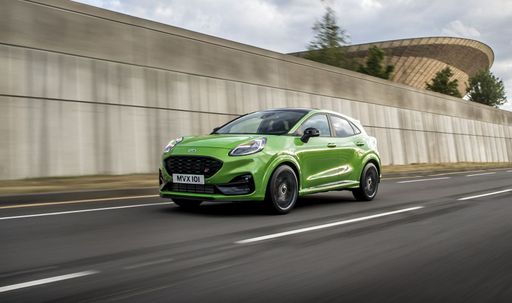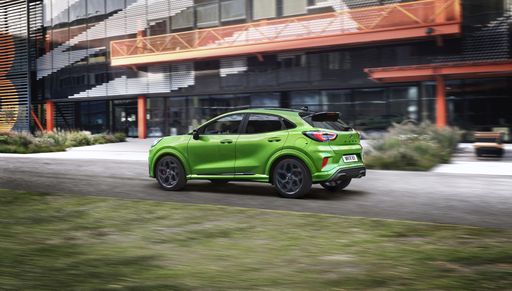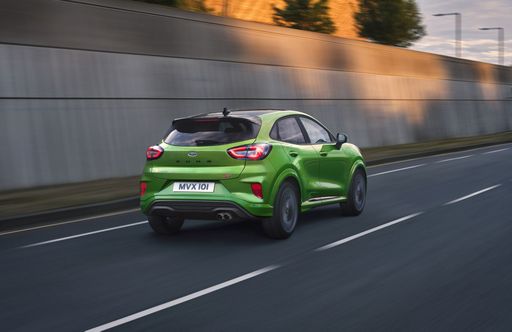Ford Puma vs Isuzu D-Max - Differences and prices compared
Costs and Efficiency:
Price and efficiency are often the first things buyers look at. Here it becomes clear which model has the long-term edge – whether at the pump, the plug, or in purchase price.
Ford Puma has a distinct advantage in terms of price – it starts at 24800 £, while the Isuzu D-Max costs 34300 £. That’s a price difference of around 9506 £.
Fuel consumption also shows a difference: Ford Puma manages with 5.40 L and is therefore decisively more efficient than the Isuzu D-Max with 8.70 L. The difference is about 3.30 L per 100 km.
Engine and Performance:
Power, torque and acceleration say a lot about how a car feels on the road. This is where you see which model delivers more driving dynamics.
When it comes to engine power, the Ford Puma has a barely noticeable edge – offering 168 HP compared to 163 HP. That’s roughly 5 HP more horsepower.
In acceleration from 0 to 100 km/h, the Ford Puma is convincingly quicker – completing the sprint in 7.40 s, while the Isuzu D-Max takes 12.60 s. That’s about 5.20 s faster.
In terms of top speed, the Ford Puma performs slightly better – reaching 210 km/h, while the Isuzu D-Max tops out at 180 km/h. The difference is around 30 km/h.
There’s also a difference in torque: Isuzu D-Max pulls to a small extent stronger with 360 Nm compared to 290 Nm. That’s about 70 Nm difference.
Space and Everyday Use:
Cabin size, boot volume and payload all play a role in everyday practicality. Here, comfort and flexibility make the difference.
Seats: offers more seating capacity – vs .
In curb weight, Ford Puma is convincingly lighter – 1316 kg compared to 1905 kg. The difference is around 589 kg.
When it comes to payload, Isuzu D-Max decisively takes the win – 1095 kg compared to 469 kg. That’s a difference of about 626 kg.
Who wins the race?
The Ford Puma proves to be outperforms in nearly all aspects and therefore becomes our DriveDuel Champion!
Ford Puma is the better all-rounder in this comparison.
 @ Ford Motor Company / Ford Media Center
@ Ford Motor Company / Ford Media Center
Ford Puma
Costs and Consumption
View detailed analysis
Engine and Performance
View detailed analysis
Dimensions and Body
View detailed analysis
Ford Puma
The Ford Puma is a cheeky compact crossover that blends sporty styling with city-friendly practicality, giving drivers a surprisingly fun and composed ride. With clever storage tricks and a lively personality, it’s a smart pick for buyers who want enjoyment without fuss.
details @ Ford Motor Company / Ford Media Center
@ Ford Motor Company / Ford Media Center
 @ Ford Motor Company / Ford Media Center
@ Ford Motor Company / Ford Media Center
 @ Ford Motor Company / Ford Media Center
@ Ford Motor Company / Ford Media Center
 @ Ford Motor Company / Ford Media Center
@ Ford Motor Company / Ford Media Center
Isuzu D-Max
The Isuzu D-Max wears its workhorse credentials with quiet confidence, delivering rugged practicality and a cabin that keeps things simple and sensible. If you want a dependable truck that gets on with the job without fuss—and even manages a bit of comfort on the road—the D-Max is a smart, no-nonsense pick.
details
 @ Ford Motor Company / Ford Media Center
@ Ford Motor Company / Ford Media Center
|
|
|
|
|
Costs and Consumption |
|
|---|---|
|
Price
24800 - 36300 £
|
Price
34300 - 50100 £
|
|
Consumption L/100km
5.4 - 5.9 L
|
Consumption L/100km
8.7 - 9 L
|
|
Consumption kWh/100km
13.1 - 13.9 kWh
|
Consumption kWh/100km
-
|
|
Electric Range
361 - 376 km
|
Electric Range
-
|
|
Battery Capacity
43 kWh
|
Battery Capacity
-
|
|
co2
0 - 135 g/km
|
co2
228 - 235 g/km
|
|
Fuel tank capacity
42 L
|
Fuel tank capacity
76 L
|
Dimensions and Body |
|
|---|---|
|
Body Type
SUV
|
Body Type
Pickup
|
|
Seats
5
|
Seats
2 - 5
|
|
Doors
5
|
Doors
2 - 4
|
|
Curb weight
1316 - 1563 kg
|
Curb weight
1905 - 2110 kg
|
|
Trunk capacity
456 - 523 L
|
Trunk capacity
-
|
|
Length
4186 - 4226 mm
|
Length
5280 - 5320 mm
|
|
Width
1805 mm
|
Width
1810 - 1870 mm
|
|
Height
1550 - 1555 mm
|
Height
1770 - 1790 mm
|
|
Max trunk capacity
1216 - 1283 L
|
Max trunk capacity
-
|
|
Payload
367 - 469 kg
|
Payload
990 - 1095 kg
|
Engine and Performance |
|
|---|---|
|
Engine Type
Electric, Petrol MHEV
|
Engine Type
Diesel
|
|
Transmission
Automatic, Manuel
|
Transmission
Automatic
|
|
Transmission Detail
Reduction Gearbox, Manual Gearbox, Dual-Clutch Automatic
|
Transmission Detail
Automatic Gearbox
|
|
Drive Type
Front-Wheel Drive
|
Drive Type
All-Wheel Drive
|
|
Power HP
125 - 168 HP
|
Power HP
163 HP
|
|
Acceleration 0-100km/h
7.4 - 9.8 s
|
Acceleration 0-100km/h
12.60 s
|
|
Max Speed
160 - 210 km/h
|
Max Speed
180 km/h
|
|
Torque
170 - 290 Nm
|
Torque
360 Nm
|
|
Number of Cylinders
3
|
Number of Cylinders
4
|
|
Power kW
92 - 124 kW
|
Power kW
120 kW
|
|
Engine capacity
999 cm3
|
Engine capacity
1898 cm3
|
General |
|
|---|---|
|
Model Year
2025
|
Model Year
2024 - 2025
|
|
CO2 Efficiency Class
A, D
|
CO2 Efficiency Class
G
|
|
Brand
Ford
|
Brand
Isuzu
|
Is the Ford Puma offered with different drivetrains?
The Ford Puma is offered with Front-Wheel Drive.
The prices and data displayed are estimates based on German list prices and may vary by country. This information is not legally binding.
